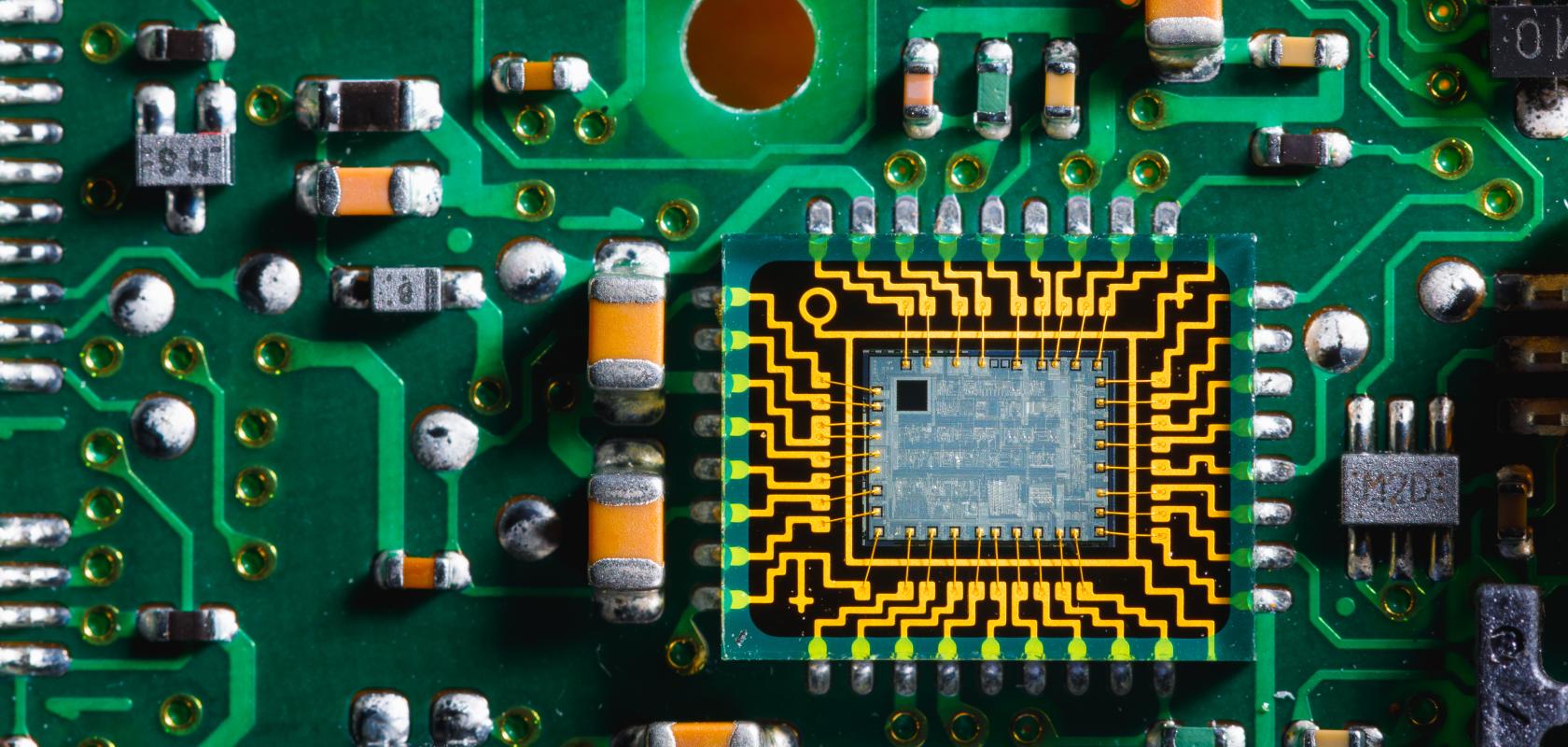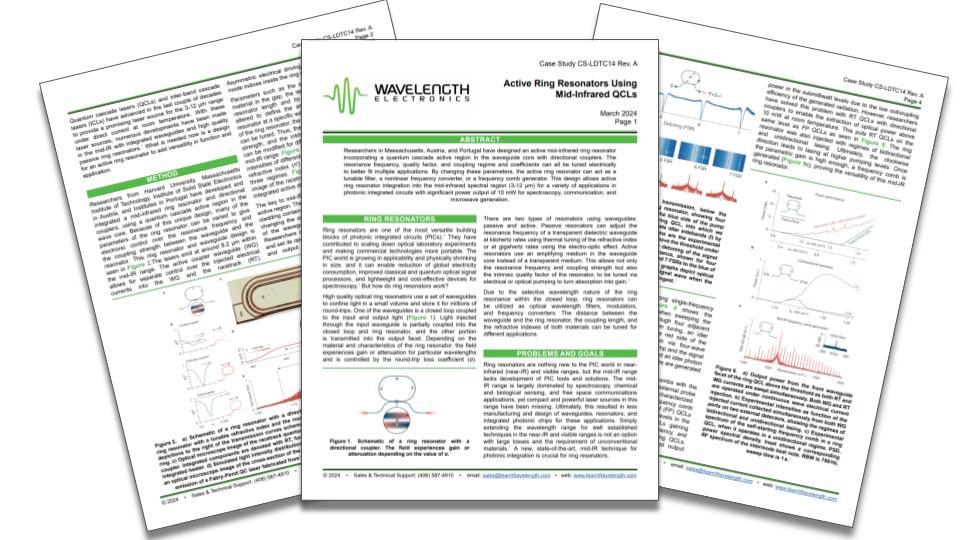Mid-infrared (mid-IR) photonics has emerged as an important field that is able to accommodate applications as diverse as spectroscopy, chemical sensing, environmental monitoring, healthcare, and telecommunications.
The mid-IR spectral range is typically defined as wavelengths between 3 to 12µm. This corresponds to the vibrational and rotational resonances of molecules, which also places it ideally for molecular fingerprinting and identification.
Photonic integrated circuits (PICs) can offer a great deal of potential for mid-infrared (mid-IR) applications, but there are equally some challenges that need to be addressed in order to fully realise this potential. As an example, some of the conventional materials used for PICs in the near-infrared (NIR) and visible ranges are less suitable for mid-IR applications due to increased absorption and material limitations.
PICs for mid-IR wavelength applications
Likewise, fabricating PICs for mid-IR applications uses more specialised techniques that can handle the materials’ individual properties, and minimising waveguide losses is vital for achieving efficient light transmission and device performance in mid-IR PICs.
In addition, the integration of optical components, such as lasers, modulators, detectors, and filters, into a single mid-IR PIC can pose their own challenges. Ring resonators, for example, are fundamental for exploiting the principles of resonance in PICs to manipulate and control light. They consist of a closed-loop waveguide structure that allows light to circulate repeatedly within the ring, leading to constructive interference at certain wavelengths.
These ring resonators have long been used in PICs for near-IR and visible ranges, where their versatility has been instrumental in downsizing optical laboratory setups and enhancing the portability of commercial technologies. However, as referenced above, the mid-IR range has not benefited as effectively as near-IR and visible ranges from solutions such as these for PICs.
A new ring resonator in the mid-IR range
Enter a team of researchers from Harvard University, Massachusetts Institute of Technology, Institute of Solid State Electronics in Austria, and three institutes in Portugal, who between them, developed a mid-infrared ring resonator and directional couplers, using a quantum cascade active region in the wave core. Jeremiah Hashley, a technical writer with Wavelength Electronics explains: “PICs applications greatly benefit from active ring resonators using quantum cascade laser (QCL) sources or gain regions in the mid-IR range. This ring resonator system broadens the range of implementations possible using mid-IR active PICs for spectroscopy, communication, and microwave generation.”

a) Schematic of a ring resonator with a directional coupler. b) Theoretical intensity transmission of the ring resonator with a tunable refractive index and the round-trip loss coefficient α in the three coupling regimes. The depictions to the right of the transmission curves schematize the light intensity distribution in the waveguide and the ring. c) Optical microscope image of the racetrack quantum cascade (QC) resonator with an integrated active directional coupler. Integrated components are denoted with RT, for the racetrack, WG, for the waveguide coupler and HT, for the integrated heater. d) Simulated light intensity distribution (λ = 7.9 μm, nRT = 3.323) in the coupling region. The inset shows an optical microscope image of the cross-section of the coupling region. e) Experimental spectrum of the sub-threshold emission of a Fabry-Perot QC laser fabricated from the same epitaxial material as the ring resonator shown in c. (Credit: Nature Communications)
The research could potentially open up a number of opportunities, thanks to the applications that can benefit from mid-IR active ring resonators. These include molecular gas sensing spectroscopy, communications, and microwave generation. Hashley says: “PICs are used all around the world due to the ability to scale down optical experiments and make them more portable, and this research enables experiments in these fields to do the same and advance in capabilities. The QCL source enabled the researchers to design this system with higher output power than previously demonstrated with ring QCLs, and with tunability using electrical control. This design is also user-defined post-fabrication, meaning that users can choose how they want the device to operate depending on the electrical control, making implementation extremely flexible. It can operate as a tunable filter, a nonlinear frequency converter, or a frequency comb generator.”
The biggest research challenge
Herein lay the biggest challenge for the team: proving that the ring resonator could function as three different devices. Says Hashley: “Proving that the ring resonator could be tuned consistently to change different parameters required precise electrical control of the resonant frequency, quality factor, coupling regime, and coupling coefficient. Essentially, the researchers performed at least three different experiments to show the capabilities of the ring resonator to operate in three different modes.”
In order to achieve this, the researchers were looking for precise current to the lasers and stable temperature control of those lasers. As only the resonant wavelength in the ring resonator experiences gain or build-up in intensity over multiple round trips, careful control of the laser output is necessary. Slight differences in injection current and variability in temperature can shift the output wavelength and result in less constructive interference and gain in the ring resonator. They selected low-noise QCL drivers and stable temperature controllers from Wavelength Electronics to ensure more consistent, repeatable results and higher performance.

a) Output power from the front waveguide facet of the ring QCL above the threshold as both RT and WG currents are swept simultaneously. Both WG and RT are operated under continuous wave electrical current injection. b) Experimental intensities as function of the injected current collected simultaneously from both WG ports on two external detectors, showing the regimes of bidirectional and unidirectional lasing. c) Experimental spectrum of the self-starting frequency comb in a ring QCL, when it operates in a unidirectional regime. PSD, power spectral density. Inset shows a corresponding RF spectrum of the intermode beat note. RBW is 750 Hz, sweep time is 1 s. (Credit: Nature Communications)
Wavelength Electronics QCL drivers
Two different QCL drivers were selected, the QCL1500 LAB and QCL2000 LAB, alongside the TC5 LAB temperature controllers to stabilise the temperature at 16ºC. Hashley says: “The QCL drivers can provide up to 1.5A and 2.0A with noise as low as 1.0µA RMS up to 100 kHz. They also offer analog modulation up to 2-3MHz with an intuitive touchscreen user interface and maximum safety features. The TC5 LAB temperature controller can provide up to ±5A to the cooling system of the laser with stability typically as low as 0.0009ºC so the temperature won’t affect the laser output. Once again, this is also a high-end benchtop instrument, but it additionally utilises Wavelength’s proprietary IntelliTune® algorithm to best characterise the thermoelectric cooler and sensor system to determine the optimal PID control coefficients.”
In terms of the results, which were published in Nature Communications[1], the research team was able to achieve a mid-infrared output (8.2µm) with up to 10mW output power from the new active ring resonator with the QCL. Looking at what this could mean for future applications, Hashley says: “This design isn’t wavelength-specific and could extend to the entire mid-IR range. Future work could generate electrically driven chip-scale femtosecond mid-IR pulse generators with power levels of 10-100W.”
Reference
[1] Kazakov, D., Letsou, T.P., Beiser, M. et al. Active mid-infrared ring resonators. Nat Commun 15, 607 (2024). https://doi.org/10.1038/s41467-023-44628-7


